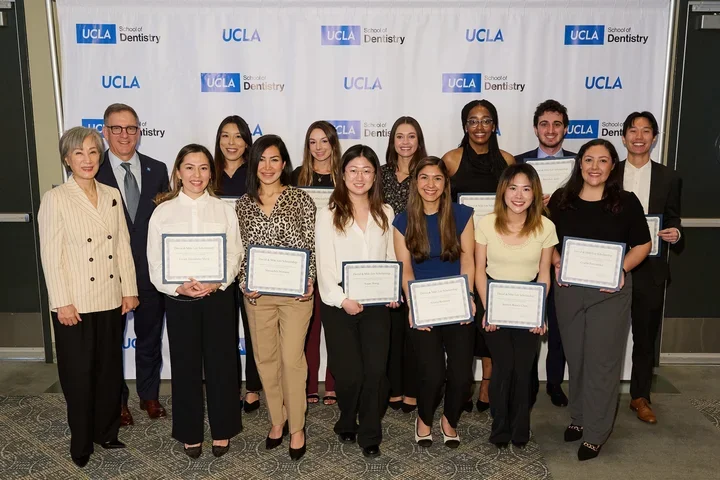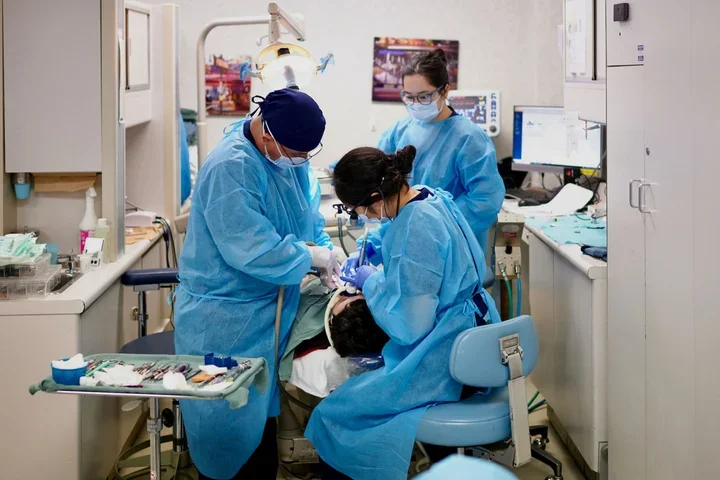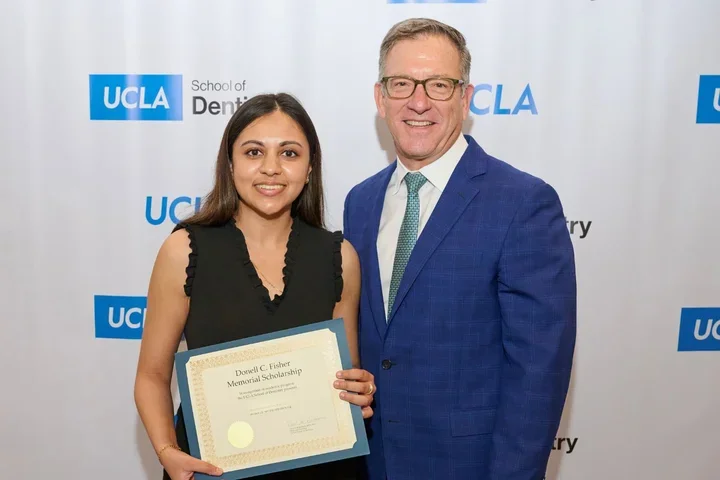Foundation for a Healthy Future
Drs. Silva and Ramos-Gomez highlight pediatric dentistry's role in children's health, focusing on prevention, cultural competence, and addressing disparities through innovative care and policies.

“I can’t explain how special it is to be a part of a child’s physical, psychological and intellectual growth… it’s truly priceless,” said Dr. Daniela Silva, associate professor and chair of the section of pediatric dentistry. “At UCLA, we train our residents to see a child differently. Our role in a child’s life is beyond treating their teeth; we are a part of their overall development.”
An old proverb says that, “it takes a village to raise a child,” and we believe that pediatric dentists are a crucial part of that village. Ideally, a patient will start seeing a pediatric dentist by their first birthday and will see them throughout their childhood into adolescence until they’re 18 years old. “After a child’s second birthday, primary care visits occur once a year and dental visits are every six months. If something is wrong, either physically or psychologically, we can spot any issues during their dental visits,” notes Dr. Silva.
A study in the journal Pediatrics showed that children who have their first dental visit before age one have 40 percent lower dental costs in their first five years than children who do not. This is due to the cost of dental and medical procedures that may be necessary as a result of poor oral health.
Establishing good oral health habits at a young age is vital to preventing caries disease and a lifetime of dental problems. The section of pediatric dentistry at UCLA creates a dental home for some of the most vulnerable pediatric patient populations in southern California. The section also understands that to create a foundation for a healthy future, it takes evidence-based research translated into effective health policies, well-trained specialists, and a collaborative approach to oral health.
“It’s the job of pediatric dentists, primary care providers, social workers, teachers, parents, and any other adult in a child’s life to provide them with the guidance and tools they need to lead a healthy, productive life,” said Dr. Silva, who is also the Thomas K. Barber Endowed Chair in Pediatric Dentistry.
ADDRESSING CHALLENGES AT THE TOP
Dr. Francisco Ramos-Gomez, professor of pediatric dentistry and director of the UCLA Center for Children’s Oral Health, has made it his life’s work to combat early childhood caries (ECC)—the number one chronic, yet preventable disease in children. As an expert on ECC prevention research and policies affecting pediatric oral health, he and his team recently organized a two-day Oral Health Innovation Forum that brought together nearly 200 health care practitioners, government officials, and members of UCLA’s health sciences. The goal of the forum, which was partially funded by the UCLA Office of Interdisciplinary and Cross Campus Affairs, was to develop innovative strategies and health policy suggestions to improve oral health care among California’s children and underserved populations.
“As a leader in pediatric health, not just localized in Los Angeles but also throughout the country, UCLA strives to be at the forefront,” said Dr. Ramos-Gomez. “We felt that a larger conversation was needed to position children’s oral health as issues of health equity, social justice, and human rights.”
A range of suggestions came out of the forum, which focused on topics facing the health care system as it relates to children’s oral health, including finance, policy developments, diversity issues, access and barriers to care, and emerging technology. There was an important emphasis placed on prevention rather than on clinical treatments, and suggestions were centered on instituting outcome-based and incentive-based reimbursement systems. Another idea was to partner with elementary schools to promote oral health and to administer mandatory oral health exams. The committees also advocated using a portion of the funds from taxes on soda, gambling, and marijuana, as well as funds from opioid lawsuits, for oral health promotion.
At the educational and training level, the idea of greater diversity was discussed, as the belief was that university admissions criteria should not only meet the demands of the institution but also the public. For example, increased diversity of health care providers could be achieved through expanding pipeline programs in mostly minority and low-income middle and high schools. Interprofessional education and cross-training between primary care providers and dental professionals was envisioned, including how medical professionals could implement oral care into their practices and how dental professionals could work alongside physicians in integrating oral health at primary care sites.
“The forum revealed the need to develop new policies to address children’s oral health. Among other strategies, a comprehensive dental visit in the first year of life could be made mandatory, which would include preventative guidance by a pediatric dentist,” said Dr. Ramos-Gomez. “Increasing access to care and reducing oral health disparities will go a long way in creating healthier communities across California and nationwide.”
TRAINING CULTURALLY COMPETENT SPECIALISTS
Many of the solutions brought up at the forum have already been implemented in the pediatric dentistry residency curriculum. Two back-to-back grants from the U.S. Health Resources and Services Administration (#D88HP20129), the first of which was awarded in 2010, have helped support programmatic changes—instead of just teaching residents to treat consequences of poor oral health, the program teaches ways to improve children’s health through disease prevention and management. Most importantly, the greatest benefit can be seen in the diversity, skills, and preparedness that our graduates possess, as well as in the quality and breadth of the comprehensive care that our patients receive.
With successful integration of the newest curriculum, which focuses on updated didactics, advocacy opportunities, and applied learning experiences at community-based organizations, the section has seen a significant increase in applicants to the program. “In the past five years, we’ve built a reputation of offering a program that has a strong clinical and didactic curriculum, along with a robust public health component, and this is reflected in the candidates who are applying to the residency program,” said Dr. Silva. “The results are graduates who are highly skilled, well-rounded, and well-prepared leaders in pediatric dentistry.”
Residents are also encouraged to focus on treating the patient holistically and within the context of the social determinants of health, including specific regional and demographic influences. “Our philosophy of care is a minimally invasive approach. And one of the most important points I tell our residents is to try to gain the trust of the children and their parents, because this trust builds a friendship and starts a dialogue to begin educating them about oral and systemic health, and how to turn inappropriate habits into good ones,” said Dr. Ramos-Gomez.
A paper published in the Journal of Dental Education in 2014 about the paradigm shift in the section’s curriculum, authored by Dr. Ramos-Gomez, Dr. Silva and additional colleagues from the dental school, outlines the positive changes they’ve seen in the graduates since the implementation of the new approach. It states, “The program shows great promise for training pediatric residents skilled in improving oral health for individual patients and the population at large, fostering interprofessional education, and integrating oral health care into the scope of other types of health care practitioners.”
One example of how residents gain real-world clinical experiences is the Infant Oral Care Program, where residents are present for an infant’s or toddler’s visit, prior to the age of one, at a partnering clinic. Residents learn about community involvement, cultural competencies, and parental engagement. This stronger emphasis on public health in the program appears to be changing the direction of many recent graduates’ career choices. The majority are still choosing to enter private practice, but an increasing number of them are choosing to practice in non-traditional clinical care settings to treat the underserved population of children in community health centers and/or federally qualified health centers. During the last six years, UCLA School of Dentistry has graduated 45 pediatric dentists and at least 14 of them are serving in these vulnerable patient population settings.
CREATING A DENTAL HOME FOR THE UNDERSERVED
Integral to the training program is addressing the needs of the patient population, and doing so in an environment that is welcoming and accessible. The dental school operates two pediatric dental clinics and rotates residents at partnering clinics scattered across the larger Los Angeles metropolitan area. In the 2017-2018 fiscal year, the UCLA Children’s Dental Center in Westwood administered over 6,500 visits and the pediatric dentistry clinic at the Wilson-Jennings-Bloomfield UCLA Venice Dental Center administered over 2,000 visits. What makes these two UCLA-operated clinics so vital to the community is that roughly 85 percent of the patient population is low-income and underserved. Many of the patients come from families that are living 250 percent below the federal poverty level. Over 75 percent of children seen at the UCLA pediatric dentistry clinics have Denti-Cal insurance coverage through the state of California, but unfortunately, there are several vital procedures that remain non-covered benefits.
Another issue that many families grapple with is that their local community clinic, which accepts Denti-Cal, may not administer advanced dental procedures. For families who have young patients who are medically compromised, or those who are frightened of dentists, oral sedation and intra-venous general anesthesia is the safest option. Unfortunately, while these services are covered by Denti-Cal, the reimbursement rate for these treatments doesn’t come close to meeting the dental school’s costs. Despite the financial loss, the clinics remain committed to accepting these special cases.
“All pediatric residents, along with our dental students, are taught to consider the outside influences that affect overall and oral health. We see a lot of children who experience toxic stress, like housing insecurity, economic hardship, or unstable home environments,” said Dr. Clarice Law, clinical professor of pediatric dentistry and an alum of the residency program. “Pediatric dentists must be empathetic to all situations, whether healthy and well-adjusted or under special circumstances. We treat our patients as if they were our own children.”
Due to the fact that many of the families who select the UCLA pediatric dentistry clinics as their dental home are predominantly low income, the section and the dental school actively seek grants and funding to help subsidize treatment and associated costs. It is undeniable that conscientious oral health care during an individual’s formative years is directly linked to overall health in adulthood. The support of partners like The Nicholas Endowment helps the Center in Westwood to be better equipped to provide care to the pediatric patients with the most urgent needs.
Administering tens of thousands of visits over the past two decades has taken its toll on the Center in Westwood, which is undergoing a massive renovation. Soon the broken equipment, worn-out chairs, and outdated space will be history. Initiated by the former dean of the dental school,
Dr. No-Hee Park, the new space will feature ten state-of-the-art operatories, two surgical suites, a new infant oral health room, a sterilization area, a reading wall, and a clinic lounge. The newly renovated Center will continue to function as a major safety net and dental home for the low-income and underserved children of West Los Angeles and its neighboring communities. The Center will also be a special place for educating and training the next generation of pediatric oral health care providers.
“We asked ourselves, how can we as a dental school and major regional provider of pediatric dental care contribute to our community and its most vulnerable members?” said Dr. Paul Krebsbach, the current dean of the UCLA School of Dentistry. “Our answer was simple. We need to invest in a new, modern clinic that can withstand the traffic of the thousands of children and their families; we need to actively engage with our colleagues about policies affecting our patients; and we need to continue training professionals who have real-world experience in an ever-changing environment for the children and their future.”
With nearly $1 Million in funding already raised to support this effort, thanks to contributions from alumni and friends, UCLA Children’s Dental Center is giving children the opportunity for a brighter future. To help UCLA Children’s Dental Center give more children the gift of a healthy smile, contact Mallory Gompert at (310) 206-6079 or mgompert@support.ucla.edu.



